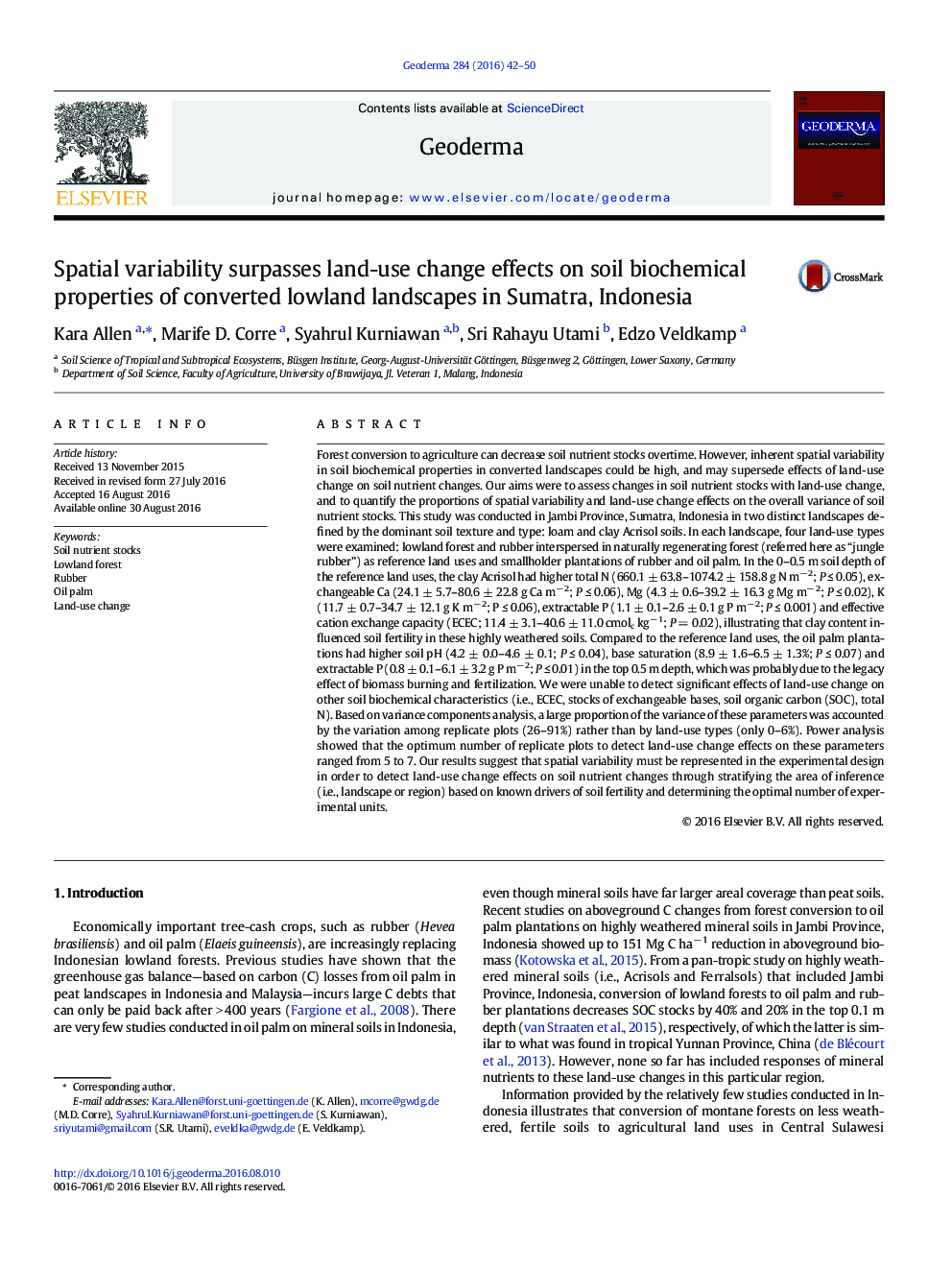| کد مقاله | کد نشریه | سال انتشار | مقاله انگلیسی | نسخه تمام متن |
|---|---|---|---|---|
| 6408273 | 1629433 | 2016 | 9 صفحه PDF | دانلود رایگان |
- N, extractable P and base saturation were higher in clay than loam Acrisol soils.
- pH, extractable P and base saturation increased with forest conversion to oil palm.
- These were likely due to legacy effects of biomass burning and fertilization in oil palm.
- Spatial variability was high in majority of soil biochemical characteristics.
- Landscape-scale investigation of land-use change should be based on known drivers of soil fertility.
Forest conversion to agriculture can decrease soil nutrient stocks overtime. However, inherent spatial variability in soil biochemical properties in converted landscapes could be high, and may supersede effects of land-use change on soil nutrient changes. Our aims were to assess changes in soil nutrient stocks with land-use change, and to quantify the proportions of spatial variability and land-use change effects on the overall variance of soil nutrient stocks. This study was conducted in Jambi Province, Sumatra, Indonesia in two distinct landscapes defined by the dominant soil texture and type: loam and clay Acrisol soils. In each landscape, four land-use types were examined: lowland forest and rubber interspersed in naturally regenerating forest (referred here as “jungle rubber”) as reference land uses and smallholder plantations of rubber and oil palm. In the 0-0.5 m soil depth of the reference land uses, the clay Acrisol had higher total N (660.1 ± 63.8-1074.2 ± 158.8 g N mâ 2; P â¤Â 0.05), exchangeable Ca (24.1 ± 5.7-80.6 ± 22.8 g Ca mâ 2; P â¤Â 0.06), Mg (4.3 ± 0.6-39.2 ± 16.3 g Mg mâ 2; P â¤Â 0.02), K (11.7 ± 0.7-34.7 ± 12.1 g K mâ 2; P â¤Â 0.06), extractable P (1.1 ± 0.1-2.6 ± 0.1 g P mâ 2; P â¤Â 0.001) and effective cation exchange capacity (ECEC; 11.4 ± 3.1-40.6 ± 11.0 cmolc kgâ 1; P = 0.02), illustrating that clay content influenced soil fertility in these highly weathered soils. Compared to the reference land uses, the oil palm plantations had higher soil pH (4.2 ± 0.0-4.6 ± 0.1; P â¤Â 0.04), base saturation (8.9 ± 1.6-6.5 ± 1.3%; P â¤Â 0.07) and extractable P (0.8 ± 0.1-6.1 ± 3.2 g P mâ 2; P â¤Â 0.01) in the top 0.5 m depth, which was probably due to the legacy effect of biomass burning and fertilization. We were unable to detect significant effects of land-use change on other soil biochemical characteristics (i.e., ECEC, stocks of exchangeable bases, soil organic carbon (SOC), total N). Based on variance components analysis, a large proportion of the variance of these parameters was accounted by the variation among replicate plots (26-91%) rather than by land-use types (only 0-6%). Power analysis showed that the optimum number of replicate plots to detect land-use change effects on these parameters ranged from 5 to 7. Our results suggest that spatial variability must be represented in the experimental design in order to detect land-use change effects on soil nutrient changes through stratifying the area of inference (i.e., landscape or region) based on known drivers of soil fertility and determining the optimal number of experimental units.
Journal: Geoderma - Volume 284, 15 December 2016, Pages 42-50
